@[Deactivated User] Hadn't really thought about it! I suppose some speakers would mouth (or even speak) along in oral Vodholk; some signs do require mouth actions but not many of them.
MV Handshapes & glossing
▲
9▲ 9 ▼ 0
weird glosses & terrible art!
This public article was written by [Deactivated User], and last updated on 28 Aug 2018, 10:14.
[comments] sign languagesignmanualglossaryhandshapesvokmvok
4. Vodholk case
?
?
5. Vodholk phonology
?
?
There are a mere 16 handshakes used in Manual Vodholk (not including modified or altered versions of the same signs). One of these is only used for counting. When naming handshapes, I use the closest ASL equivalent as listed on the images below.
Most of the handshapes are used at least on occasion in a way that corresponds with spoken sounds; for instance, many words that begin with /k/ also begin with the handshape listed below as Y. 🤙
Each of the handshapes are also categorized as open, closed, or pointed, with the exceptions of 3 and N. This is because in MV, the non-dominant hand is generally not assigned an explicit handshape but merely one of those three categories. If the dominant handshape fits into the category, the nondominant will often match it; otherwise it can (generally) occupy any appropriate handshape as per the signer's preference. 3 and N are unique and must always be produced accurately by the nondominant hand.
Note that in the below handshape dictionary, the direction of the hand is not important - just the shape of it, which was drawn from the angle thought to explain it best.
I apologize for the poor quality of the drawings but hope that they, combined with their captions, will suffice to explain the different handshapes.
Closed handshapes are the smallest category of handshapes, with only three. (They also tend to be the literal smallest, since the hand is closed up.)
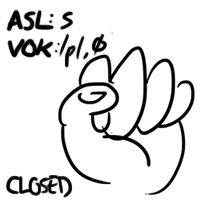
S is a simple fist, with the thumb in front of the closed fingers. This is often associated with /p/ in SV, and is used as the number 0 in finger-counting. ✊👊🤛🤜

O is a circle formed with the tip of the thumb touching the index finger, with the rest of the fingers closed in together next to the index. It is sometimes associated with /u/.
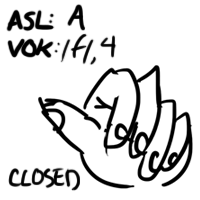
A is a thumbs-up. It can be formed with the fingers curled under themselves, as in a fist, or open across the palm, as pictured. The thumb explicitly must stick out, unlike in ASL, where it is tucked beside the fist. A often represents the /f/ sound. 👍

Y looks like its namesake; the central fingers are all closed, while the thumb and pinky extend off to the sides. In MV they may also extend upwards. The closed fingers usually extend along the palm as in A, but can be curled up like an impartial fist. It is associated with the sound /k/.
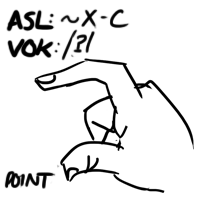
X is not exactly equivalent to ASL X. Instead, the index and thumb form a C-shape, while the other fingers are curled together. (It is a bit like ASL G, but the space between thumb and forefinger is much broader.) X represents /i/.

1 is a classic pointing-hand; the index is extended and all other fingers are closed. In a variant, like ASL D, the other fingers form a circle together. 1 is often associated with /a/, and as in ASL it represents the number 1. 👆👉👇👈☝️
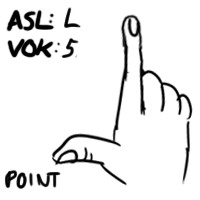
L is an extended thumb and index finger, with all other fingers curled closed. L represents the number 5, but no sound, except occasionally /a/.
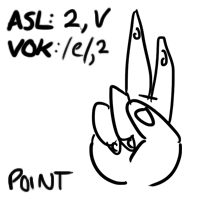
2 is like the "peace" sign sometimes used in English gesturing: it has the index and middle finger extended, with the other fingers closed. The extended fingers can be touching or closed, as in ASL U or V. This shape relates to the sound /e/ and the number 2. ✌️
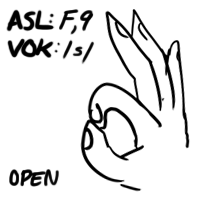
F is like the sign sometimes used for "perfect" in English gesturing: the thumb and index form a circle (or a "pinchy" shape), while the other fingers are extended and splayed. It demonstrates the sound /s/. 👌

W has the three centre fingers (index, middle, and ring) up, with the thumb and pinky curled down together. It is associated with SV /o/ and shows 3 in finger-counting.
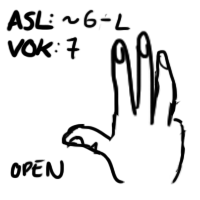
7 is the only sign that will be glossed with its VM meaning at all times, since there is no clear ASL equivalent. 7 involves all fingers but the pinky being extended. It is a somewhat more difficult handshape to produce, and sometimes both the pinky and ring finger are curled, instead of just the pinky being fully lowered. As suggested, it is number 7. It occasionally but infrequently is associated with /o/.
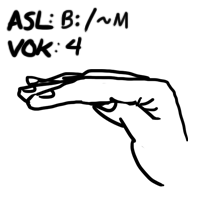
B: or 5: (bent B/5), usually just glossed as B, involves the thumb being tucked into the palm, all the fingers up but together, and then the fingers bending over the thumb so that the hand forms something of a right angle. It is an alternate representation of number 4, but is not associated with any sound.
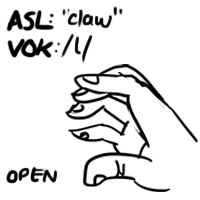
CLAW, henceforth C, is an open hand with all five fingers up and separate, but bent, in a claw-like fashion. This handshape should be made in a way that might be appropriate for picking up a bowling ball if it had five holes. It is associated with the sound /l/.
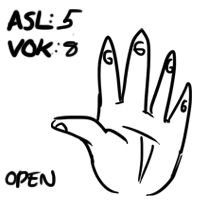
This shape is simply an open hand, all fingers up and splayed. It can also be produced with the fingers closed together. It does not represent any sound but is used for number 8. ✋🤚🖐️
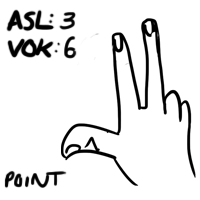
3 is similar to a "peace" sign combined with a thumbs-up: the thumb, index, and middle fingers are all extended, while the pinky and ring are curled down. It represents number 6 and sometimes the sound /e/.

N is produced either exactly like ASL N (index and middle finger extended but bent over the thumb, other fingers down) or as pictured: the thumb separates the index and middle from the ring and pinky fingers, but all remain (mostly) extended. It represents the SV /θ/ (English "th"). 🖖🏻...vaguely.
In the dictionary I try to describe the motions and placements of signs in words, but sometimes it is simply much easier to use a glossing technique of sorts.
The basic structure is:
handshape.palm-orientation location motion.direction
--> second handshape and/or location
A few examples of MV glosses (in underlines) with fuller explanations of the signs in brackets:
CHILD aésa
1.you temple fall.you
(a 1 handshape with the palm to the addressee, positioned with the tip of the index at the signer's temple, moves forwards in a falling motion towards the addressee.)
FERMENT papsa S.you sky twist --> bury.under 5flat.down (the dominant hand makes a fist with the palm facing the addressee, slightly above the signer's eye level. the fist makes a twisting motion. the nondominant hand makes a (closed) 5 or B shape, with the palm facing downwards, and the fist, now facing downwards, is pushed once or twice below the B.)
MORNING lé'el 1.down.you on 5flat.up (a 1 or L-shape, palm downwards, pointing towards the addressee, rests on a closed 5 with the palm upwards.)
FERMENT papsa S.you sky twist --> bury.under 5flat.down (the dominant hand makes a fist with the palm facing the addressee, slightly above the signer's eye level. the fist makes a twisting motion. the nondominant hand makes a (closed) 5 or B shape, with the palm facing downwards, and the fist, now facing downwards, is pushed once or twice below the B.)
MORNING lé'el 1.down.you on 5flat.up (a 1 or L-shape, palm downwards, pointing towards the addressee, rests on a closed 5 with the palm upwards.)
These glosses are used to pare down the number of words needed to describe a sign without having to resort to making comics, videos, or gifs to explain how signs are performed.
This section will continue to be updated as new glosses become more-often used and/or questions are asked!
- Linguistic glosses & sign descriptors
- DH: dominant hand
- ND: non-dominant hand
- PPOA: passive place of articulation; can be the ND, or another body part, that is static while that DH is active
- PO: palm orientation. which direction the palm faces.
- HS: handshape (see above!)
- MOV: movement or motion of the sign
- NM: non-manual, including posture shift, facial expression
- neutral: a sign, usually a noun, which is made without specific location requirements (e.g. doesn't have to be in the sky, or on the signer's body)
- specified: a sign which is made in contact with the signer's body or in a specific position (such as the 'sky' position).
- directional: a type of verb in which the direction of action is indicated through the verb itself, for instance starting near the signer and ending up near the addressee to indicate that the signer is acting on the addressee.
- static: nouns and non-directional verbs are called static signs.
- kla: the lowest-volition marker.
- DH: dominant hand
- positions
- Ø - position unspecified: neutral position, generally at about chest level.
- ↑, upper sign space: slightly below eye level, but above chest level. Neutral nouns are placed here to receive agreement marking.
- ↓, lower sign space: at chest level or slightly lower. Neutral nouns are placed here to receive agreement marking.
- sky: above the signer's eye level, or sometimes above the head. Generally more than one hand's-length in front of the signer. Associated with things that go in the sky or high off the ground.
- cross: the hands cross at the wrist
- clap: simply means the two palms are together, or at least facing. 🙏👏
- spread: hands are side-to-side to create a large 'screen'. 👐
- Ø - position unspecified: neutral position, generally at about chest level.
- handshape and palm orientation
- you, to.you: palm facing the addressee
- me, to.me: palm facing the signer
- in, inwards: thumb upwards
- out, outwards: thumb downwards
- flat.down: palm facing downwards, not the fingers. ND 5flat.down often represents the ground. ND 3flat.down is the base for many colour signs.
- flat.up: palm facing upwards. ND 5flat.up often represents water.
- you, to.you: palm facing the addressee
- common motions (often +location and/or PO)
- wave: move side to side. 👋
- backhand: generally with the palm to.me, near but under sky, make a sharp motion towards the target, often with snapping of the wrist
- swim: usually PO down, make an undulating forwards motion reminiscent of the hand swimming through water. often used for sea creature nouns.
- earcircle: most extended fingers touch under and behind the ear and circle forwards overtop of it. often used for humanoid species names.
- lick: the hand is placed near the mouth and makes a nodding motion at it; the tongue may be extended but does not actually need to lick the hand.
- pluck: usually with a closed or pinching (X, F) handshape, DH 'removes' something off/out of ND/PPOA
- wave: move side to side. 👋
Comments









